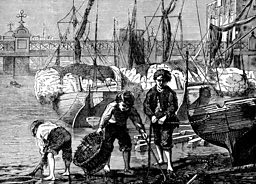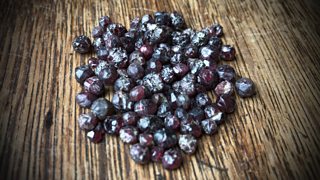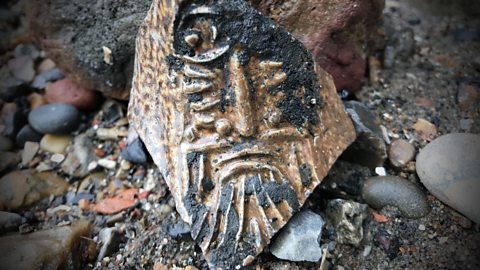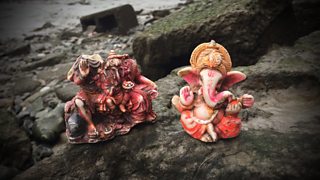Five items that tell the story of the River Thames
In 18th- and 19th-Century London, mudlarks were impoverished citizens (often children) who scraped a meagre living by scavenging for sellable items in the stinking mud of the Thames at low tide.
Modern-day mudlarking, you’ll be pleased to hear, is an altogether cleaner and pastime. And what treasures it reveals…

Here are the objects.

1. Roman pottery
This fragment almost looks like a sample of something you might buy in a posh homeware shop – but it actually dates all the way back to the 2nd Century AD, when it formed part of the rim of a Roman cooking pot or bowl. This piece was found near the centre of the city, right where the Roman city of Londinium was settled, in around AD43.
London in the 1st century was far from the hospitable place it is today. In fact, the Thames (and the access it afforded from the sea) was probably one of the only reasons the Romans decided to stick around there in the first place.
Londinium soon became a bustling port – and that’s why many of the items on the Thames foreshore that date from this period originally hail from overseas. This particular shard, though, is from much closer to home. It’s made of clay dug in the Thames Estuary.
2. Pins

Mudlark treasure: Pins found in the River Thames
Pins are found with surprising abundance in the river.
These ones were individually hand-made from copper alloy and date from anywhere between 1400 and 1800.
Pins are what Londoners of the past used to hold their clothes together before zips and velcro were invented. Although people literally relied on them to get dressed in the morning, they weren’t exactly easy to produce. Pin-making machines weren’t invented until the late 18th Century. Prior to this, each individual pin was made with wire and a soldering iron before being polished and sharpened to a point.
And pins weren’t ten-a-penny, either – in fact, they were more like 100-a-penny, which wasn't cheap by 16th-Century standards. Still, they were claimed by the river in great numbers – dropped by the people who worked on the Thames, or pitched in with muck from the streets and household waste. Watch your step.
-
![]()
Listen to the podcast
Subscribe to Time Travellers to download this episode and browse all previous editions of the quirky history podcast.
3. Garnets
The secret of where and how to find Thames garnets is closely guarded by London mudlarks. They’re found in very specific locations, but no-one can quite agree on how they got there. Garnets are dark red gemstones that have been discovered in metamorphic, igneous, and sedimentary rock around the world. (If you want to get REALLY technical, they’re nesosilicates with the general formula X3Y2(SiO4)3.) But the thing about the Thames garnets is – they’re not from the Thames.

No-one really knows why London mudlarks keep turning up dozens of these uncut gemstones, the majority of which aren’t valuable. Theories range from sacks of gemstones falling off ships as they came into port (by accident or otherwise) to thieves attempting to get rid of the evidence of a robbery.
Some people have pointed out that garnets have been used in jewellery since medieval times – could these ones be the forgotten sweepings from a shop floor? Others think that they were simply part of an abrasive cleaning product. We just don’t know.
4. Bellarmine bottles

Mudlark treasure: Bellarmine bottles
Stoneware with personality.
There’s a lot of pottery on the Thames foreshore, but by far the jolliest kind that a London mudlark can hope to find is that of a Bellarmine bottle (AKA Bartmann jug); it's a glazed stoneware product from Germany that was hugely popular in 16th- and 17th-Century London.
It’s easy to see why. The thing that makes Bellarmines stand out is their signature detail: a bearded face peeking out from the lower part of the bottle’s neck, with an expression that can be grotesque, jovial or simply daft.
Bellarmines were used to serve beer and wine in the taverns that lined the Thames – so, no prizes for guessing how they might have found their way into the river. While the bearded figure they depict was probably the “Green Man” of northern European folklore, their English name was a snide dig at a 17th-Century Italian cardinal called Bellarmine, who was a fierce opponent of Protestantism – and alcohol.
5. Modern Hindu offerings
These plastic statues are a reminder of the important role that the Thames has had (and continues to have) in Londoners’ spiritual lives. For some Hindu Londoners, the Thames has become a stand-in for the Ganges (FYI: the two rivers are twinned). Mudlarks like Lara Maiklem have found statues, flowers, beads, coconuts, ghee lamps and even jewellery washed up along the shore in recent years.

But then the Thames has been the silent recipient of human offerings for hundreds of years. Mudlarks have found Bronze Age weapons, Roman coins, Wiccan spells and Christian rosary beads, as well as votive offerings like these Hindu statues. The river still holds a sacred place in many Londoners’ lives.
All of the images in this article are by Lara Maiklem. Lara is the founder of the and has mudlarked on the Thames foreshore – which she describes as “the longest and most varied archaeological site in the world” – for 15 years. Her book, Mudlarking: Lost and Found on the River Thames, will be published in August.
Lara appears on a special edition of Time Travellers, the quirkiest history podcast around. Subscribe to the podcast and catch up with this special mudlarking episode from Friday 17 May.
-
![]()
Time Travellers
Subscribe to the the podcast that shines a light into the corners of history.
-
![]()
Essential Classics
Refresh your morning with a great selection of classical music, presented by Suzy Klein and Ian Skelly.
-
![]()
Words and Music
A journey along some of the world's greatest rivers, from the Nile to the Yangtze, the Ouse to the Severn and the Suck.
-
![]()
In Tune Mixtape
A seamless mix of well-loved and little-known music celebrating the river.




